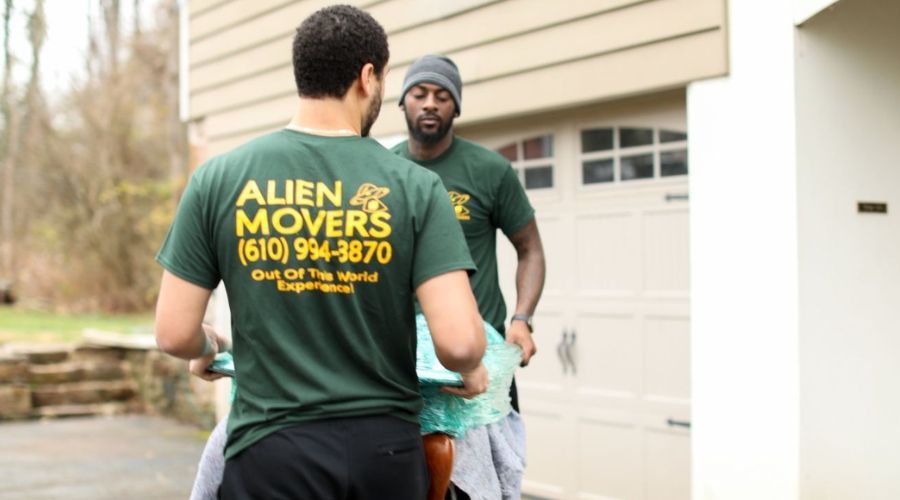By Carson Williams
•
February 6, 2024
Are you getting ready to move to a new home? Whether it's across town or across the country, moving can be a lot. But don't worry, we're here to help! In this ultimate moving checklist guide, we'll walk you through everything you need to do to make your move smooth. From packing and planning to finding the right movers, we've got you covered. So, grab a pen and paper and get ready to make your moving process a breeze! Planning Ahead for a Smooth Move Understand the Importance of a Moving Checklist A moving checklist is important. It helps keep track of all the tasks and details involved in the relocation process. This ensures that nothing is overlooked or forgotten. By using a moving checklist, individuals can benefit from a more organized and efficient move. It helps them stay on top of essential tasks such as packing, hiring movers, transferring utilities, and updating their address. A moving checklist can reduce stress during what can be a chaotic time. It helps individuals prioritize their tasks and manage their time effectively, ultimately leading to a smoother transition to a new home. Additionally, a moving checklist can help individuals budget and allocate resources appropriately. This prevents any last-minute scrambling or oversights. Identify Your End-to-End Moving Solutions Identifying your moving solutions is important for a smooth move. This includes packing, arranging transportation, and unpacking at the new place. Creating a detailed checklist, getting permits, and hiring professional movers are helpful for a successful move. Professionals can help with packing delicate items, handling logistics, and ensuring safe and timely delivery. Using these solutions can help manage complexities and reduce stress during a move. Moving Checklist: 8 Weeks Before Moving Research and Select Move People When choosing a moving company or professional, consider these factors: reputation, experience, and pricing. A reputable company will have positive reviews and proper licenses. Experience with your specific type of move, like local moving or long-distance moving , is crucial. Get quotes from multiple companies to make an informed decision. Check for complaints or disciplinary actions with the Better Business Bureau or the Department of Transportation. Ask for references and inquire about their policy for damaged or lost items. Research their credentials online, check their website, and look for affiliations or certifications. Ask for proof of insurance and get a written contract with all the terms and conditions. This will ensure reliability and avoid potential issues. Sort and Declutter Your Belongings When preparing for a move, start by sorting and decluttering belongings. Determine which items are essential and frequently used. Consider donating, selling, or discarding anything unused in the past year. Think about the size and layout of the new space, and sentimental value of items. Efficient organization and packing are crucial to a successful move. Pack items from the same room together, label boxes clearly, and create an inventory of all belongings for easier unpacking. Use storage solutions like bins, dividers, and vacuum-sealed bags to maximize space and keep items organized. These steps will reduce the amount of items to move and create a more manageable process. Create an Inventory of Items When making a list of things for moving, it’s important to include items like furniture, electronics, kitchenware, clothes, and personal stuff. The list should be organized and recorded using a spreadsheet or inventory software. This should note each item, its condition, and any special handling needs. It might also help to have photos or videos of the items. The responsibility for making and updating the list usually falls on the homeowner or renter who is moving, but it can also involve family members, roommates, or professional movers. Whether it’s done solo or with others, the list should be regularly updated to make sure everything is tracked during the moving process. 6 Weeks Before Moving: Engage with Professionals Choose a Reliable Moving Company When choosing a reliable moving company , make sure they are licensed and insured for the safety of your belongings. Reading customer reviews and ratings can help evaluate the company's reputation and reliability. Asking for referrals from friends and family is also a practical way to find a trustworthy option. Consider the company's experience and expertise in handling different types of moves, such as long-distance or international relocations. Transparency regarding pricing and services offered is also important for a smooth move. Clear communication and a written contract with all terms and conditions outlined will provide peace of mind during the moving process. Set Up a Moving Budget Setting up a moving budget involves considering all the expenses related to the move. These include costs for hiring a moving company , renting a moving truck, purchasing packing supplies like boxes and tape, and covering travel expenses such as gas and meals during the move. It's important to prioritize and allocate funds within the budget. Start by identifying the most significant costs, like hiring professional movers, and then allocate funds accordingly. For instance, if hiring a moving company is a top priority, allocate funds for this expense before considering other costs, such as packing supplies. It's also a good idea to set aside a portion of the budget for unexpected expenses, like repairs or last-minute accommodations. This can provide a safety net and prevent overspending. By carefully considering necessary expenses and prioritizing costs, individuals can effectively set up a moving budget that meets their needs. Order Packing Supplies When getting ready for a move, make sure to have the right packing supplies. This means sturdy moving boxes, bubble wrap or packing paper, packing tape, and markers for labeling. The quantity of each supply will depend on the size of the move, but it's best to order more than originally estimated to ensure everything can be properly packed. For fragile items like dishes or glassware, extra bubble wrap is recommended for better protection during the move. Different sized boxes are helpful for various items, and wardrobe boxes can be useful for clothing or linens. Having the right amount and variety of packing supplies can make the moving process smoother and less stressful. 4 Weeks Before Moving: Notify and Update Update Address with USPS When you update your address with USPS, you will need to provide your full name, old and new address, contact information, and the date when the change of address should take effect. It's best to complete this process at least two weeks before your move. This ensures that your mail is forwarded to the correct address without interruption. Updating your address with USPS is often free and can be conveniently done online, at your local post office, or through the mail by filling out a Change of Address form. Ensuring your address is updated with USPS helps avoid inconvenience caused by mail being delivered to your old address after you have moved. Notify Service Providers and Subscriptions It's important to notify all service providers and subscriptions before the move. This includes utilities, internet, cable, magazines, newspapers, and meal delivery services. Make sure to communicate any changes or instructions, like updating your address or transferring services. Cancel subscriptions that are no longer needed. Also, identify new providers needed for the new location, like internet or utility companies. Addressing these aspects early can help ensure a smooth transition without disruptions. Transfer or Set Up Utilities After telling the current utility providers about the move and arranging to transfer or cancel services, it's important to find and contact new utility providers for the new place. This means researching and reaching out to set up services at the new location. Making arrangements for any deposits or fees required to transfer or set up utilities is also necessary. For example, it's important to contact the local water, gas, and electricity companies to ensure a smooth transition. It's also important to ask about any necessary paperwork. Additionally, setting up internet and TV services through the right providers in the new area is very important. It may also be helpful to schedule the turn-on dates for these services to match the moving date. For instance, scheduling a turn-on date for electricity at the new location to match the moving date ensures there is power available upon arrival. 2 Weeks Before Moving: Begin Packing Start Packing Non-Essential Items When preparing to move, start packing non-essential items around two weeks before the moving date. These items can include seasonal decor, books, off-season clothing, or rarely used kitchenware. Efficiently pack non-essential items using sturdy cardboard boxes. Label each box with its contents and securely seal them with packing tape. Consider the weight and fragility of the boxes when planning their transportation to the new residence. Also, plan for their unpacking and organizing in the new home to streamline the moving process. By considering these practical tips, individuals can effectively pack and transport their non-essential items, ensuring a smooth and organized moving experience. Plan for the Transportation of Pets and Plants When planning to transport pets and plants during a move, it's important to consider their safety and well-being. For pets: Transport them in secure carriers or harnesses to prevent escape. Familiarize pets with their carrier before the move to reduce stress. Ensure pets have identification tags with updated contact information. Schedule regular breaks for pets to stretch and relieve themselves during long journeys. For plants: Carefully pack to prevent damage to leaves and stems. Secure in the moving vehicle to prevent toppling. Research specific requirements for each type of plant to ensure proper care during the move. By carefully planning for the transportation of pets and plants, the move can be much less stressful for everyone involved. Dispose of Prohibited Items Prohibited items should not be packed or moved. These include hazardous materials like aerosol cans, paint, and pesticides. Flammable items such as gasoline, propane tanks, and fire extinguishers are also not allowed. Batteries, cleaning solvents, and ammunition are on the list too. It's important to properly dispose of these items before the move because they can pose a safety risk. Home improvement stores, recycling centers, and local waste management facilities often offer disposal services for hazardous and flammable items. Community drop-off events and household hazardous waste collection programs can provide a safe and environmentally friendly way to get rid of these prohibited items. Researching local regulations and guidelines for proper disposal is essential to ensure a safe and compliant approach to the moving process. The Week of Moving: Finalize Details Pack Your Essentials Box When you move, it's important to pack an essentials box. This box should have things like toiletries, medications, a change of clothes, phone chargers, important documents, and snacks. It's best to pack this box in a separate, easy-to-spot container, like a plastic tote or a duffel bag. Also, label it clearly for quick access during the move. Keep the essentials box with you or in the car instead of putting it in the moving truck. This way, you'll have it right away when you get to your new place. Before transporting the box, make sure everything is secure and any fragile items are well-padded. Pack it tightly to prevent things from shifting during the move. This way, all your important items will get to your new home safely and ready to use. Confirm Moving Day Details with the Moving Company Confirming the details of moving day with the moving company is very important for a smooth move. This includes confirming the date, time, and location of the move, and any special requirements or services needed. Also, providing the moving company with any important documents or information, such as a floor plan of the new location or contact information for the building manager, can help ensure a seamless moving process. It's best to contact the moving company well in advance, ideally a few weeks before the moving day, to confirm all the necessary details and make any last-minute arrangements. This can help minimize potential issues or delays on moving day. Prepare Appliances for the Move Large appliances need preparation before moving. Clean and defrost the refrigerator. Ensure the washing machine drum is empty. To safely disconnect and secure appliances: Unplug them. Remove detachable parts. Secure all doors and cords to prevent movement during transit. Pack delicate or sensitive appliances with extra care: Use original packaging if available. Wrap them in bubble wrap and secure in sturdy boxes. This minimizes the risk of damage during the move and ensures they arrive in good working condition. Moving Day: Execute Your Plan Protect Flooring and Walls Protecting flooring and walls during a move is important to prevent damage. Cardboard or plastic floor protectors can safeguard hardwood floors and carpets from scratches, dents, and spills. Moving blankets can also prevent scuffs and scratches on walls and floors. Simple techniques like removing shoes or using furniture sliders can minimize risks. These protective measures can help avoid costly repairs or replacements and keep flooring and walls in good condition. Supervise Movers and Transportation The supervisor has to check the moving company's credentials, insurance, and customer reviews. They should also ensure that fragile and valuable items are packed and labeled properly, and that secure packaging materials are used. Coordination with the moving company to set a timeline and make necessary arrangements, like reserving parking spaces, is important. During the move, the supervisor needs to stay in touch with the movers to ensure everything is going as planned and address any potential issues. By overseeing these aspects, the supervisor can help make sure the move goes smoothly. Two Weeks After Moving: Settle In After two weeks of moving into their new home, the new residents are starting to feel at ease in their new surroundings. They've unpacked important items and organized their living space to make it cozy. Besides settling in, they've reached out to their neighbors and are getting involved in the community. They're exploring local events and getting to know the area, helping them to feel like they belong and are becoming part of the neighborhood. Moving Checklist PDF: Download for Reference Get your hands on our comprehensive Moving Checklist PDF, crafted to ensure nothing gets left behind. Perfect for printing or keeping on your device, this checklist is your ultimate reference for a streamlined move. Click to download and start ticking off tasks today!











